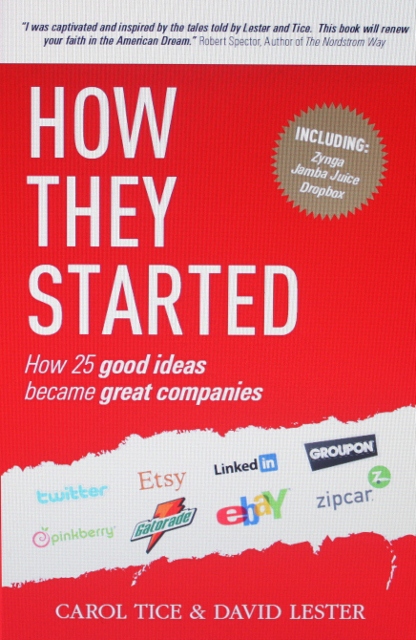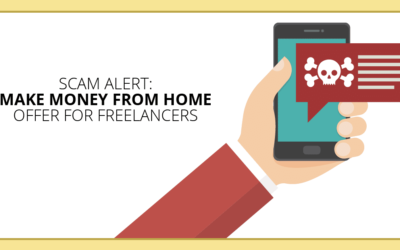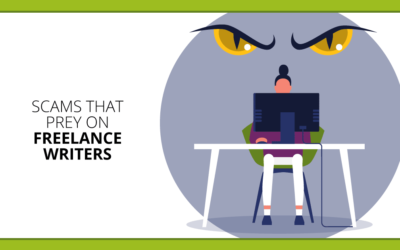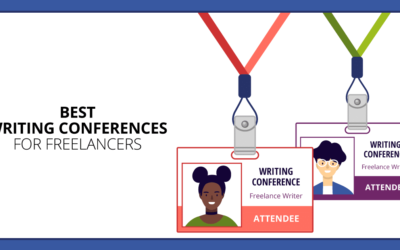
It has been a surreal journey to say the least.
It was around 2008 or so when it dawned on me that the logical next step for my freelance-writing career was to move up to the book-writing level. So it’s been a four-year slog from when I set this as a goal to making it happen.
Here’s the dirt on how my book deals happened…and what I learned that could help you snag one for your ownself.
If you want the short version: they both came about from my blogging.
It began with my blog…
In the beginning, I started this blog on my writer site, caroltice.com, back in 2008. I didn’t post much.
In 2009, I decided to get serious about providing tips to writers, and started posting weekly.
Around the same time, I was chatting with one of my editors at Entrepreneur magazine, on the print side. She mentioned that one editor who had been blogging for them had just been fired, and now they had decided they should have a freelancer take that over.
I had maybe a dozen posts up on my blog at this point. They didn’t care.
“Oh, you know how to blog? That’s great!” They bit.
I started blogging three times a week for Entrepreneur, a gig that would continue for more than three years.
I learned a lot about writing a great blog post along the way. Instead of slapping up a quick whatever, I treated each post like it was an article in a magazine.
I started to get a lot of traffic — 1,000 retweets became fairly common.
Takeaway: Do your best writing on your blog, and blog for the biggest-traffic place you can get in at, because it opens the door to a lot of opportunities.
Book nibbles
Going from just blogging for my own tiny blog to blogging for a site with 1 million monthly readers was huge, to state the obvious. I started getting a lot of small-business clients who found me through the blog.
I also started to get nibbles from CEOs thinking about teaming with a pro writer to do a book.
In 2009 and 2010, I went on a half-dozen first-meet interviews to ghost different CEOs books. All the opportunities seemed interesting, but in some cases there were only nebulous, early plans — no outline, no firm timeline of when they wanted it done or even what it would be about.
There was a missing link: a personal connection of some kind between me and the CEO. After all, they’re not going to trust just anyone with their story. I came to feel this is why these deals didn’t happen, if in fact these CEOs ever got their book plans off the ground.
Note to all writers: Loads of CEOs SAY they want a book ghosted, but way fewer of them will actually get it together to do one. There will be many flakes.
Even though these were all busts, rather than feeling defeated by that, I felt encouraged. These were signals that I could be a book author.
Then, in the summer of 2010, I got this funny phone call from this enthusiastic British guy. He said his name was David Lester, and he was a former tech-CEO turned book publisher.
He was a fan of my Entrepreneur blog posts. Huge, huge fan.
This, it turns out, is who is going to give you a book deal. Someone who isn’t just casting about for a writer. Someone who’s in love with your writing.
His firm, Crimson Publishing, had this book series, How They Started, where each chapter is a profile of a name-brand business’s early years and how they got the thing off the ground. They’d done a couple versions on global and UK-based brands, and wanted to do one with all U.S. brands — Chipotle, Groupon, Twitter, Etsy, and so on.
As a longtime business reporter, that sounded like a great fit for me. We had a wonderful chat.
Then, David disappeared for an entire year. And I forgot all about it.
Just another flake, I thought. Whatever.
Takeaway: You may need to kiss a lot of frogs to find a nonfiction book deal, but just keep trying.
A real deal
Last summer, David popped up again. “We’re ready to start the book!” he said.
They wanted to assign me eight of the chapters. Other writers would be taking some of the other chapters.
We hammered out a contract. I got paid as I wrote and don’t get a royalty, is the deal I struck (though feel free to click that book cover up top so I can get an Amazon affiliate commission).
I wouldn’t get a cover byline, but would be credited inside for my chapters.
I started in August and it was supposed to be done Oct. 31.
Real final date: Feb 12, 2012.
The toughest job I ever loved
What happened? Well.
In the UK, it seems, company CEOs are all excited when you say you want to feature them in a book.
In the U.S….not so much.
Also, at least one of the founders they wanted me to interview turned out to be…dead. Seems no one had researched very closely before assigning these profiles to me.
I think I called up my editor and sort of had a mini-breakdown at that point. I was ready to forget the whole thing.
Somehow he talked me down off the ledge.
Getting the other founders — who were still alive — to talk to me about these startup stories — people who’d been there at the start — wasn’t so easy.
How did I cope? Well, I learned a lot of new reporting tricks.
Looking under social-media rocks
I got one founder by commenting on his blog. A couple of key investors through InMail on LinkedIn.
I discovered that many tech venture capitalists no longer look at email. EVER. Twitter worked better.
For one story, I pulled out a connection to a VC I hadn’t used in five years…and he handed me the founder’s cel-phone number.
There was no one way to report the chapters. Each one posed a different challenge.
I learned that while a CEO may not talk to you, with tech startups it might hardly matter, because they have run their mouth off at a million conferences and it’s all on YouTube.
I landed some great interviews — victory! — and brought back some kick-ass stories.
Crimson liked what they read. They assigned me three more chapters.
I kept trying to jam these major investigative projects inbetween all my other writing assignments.
It was insane. I worked 8-midnight a lot.
I kept thinking of The Phantom Tollbooth, and how the task was actually impossible, except no one told Milo until he had rescued the princesses…
On the plus side, Crimson didn’t seem terribly concerned that it was taking forever. So I just kept going, researching my brains out and getting more stuff.
Until one day, when I got an email that said: The copy editor starts next week.
All the remaining work had to be finished NOW. More insanity ensued.
Then suddenly, I was done writing it.
Takeaway: Get ready to stretch and challenge yourself, and push your skills to the limit as you move up to the book level.
How to write 3,000-word book chapters
So here’s the thing. How do you take about 100 links to interesting stories about a company, a few interviews, and a mess of other interesting factoids and turn it into a fascinating book chapter?
At first, I was drowning in information. I’ve written magazine features this long before, but never ones with this much research in them.
After a little trial and error, I came up with a system that allowed me to only touch each piece of research once.
When I found something interesting, instead of just noting the link, I would immediately extract the key information and place it in a timeline of when it took place in the company history.
Presto! I basically created a rough draft as I went. At writing time, it was a question of:
- organizing it under some catchy subheads
- finding a compelling way to say each event that occurred
- figuring out where to put those snappy quotes
Mostly, it was about boiling it down…and down…and down. Some first drafts were twice the final length — there was just so much interesting stuff! But it had to go.
Takeaway: If you’re going to get through this, you’ve got to get organized.
The secret to writing a great first print book
I haven’t told anybody this. I don’t even know if I should.
But I think it was the key to getting this book done and helped me avoid having a total nervous breakdown over the fact that I Was Writing My First Print Book.
Here was the thing: I never really thought it was a book.
The idea was sort of unreal to me.
Maybe my brain was protecting me, like happens in a car accident or other trauma, where you can’t remember it later.
I didn’t have a picture in my mind of this book on a bookshelf in a bookstore.
I think that would have crushed me and I would have ended up in a corner sucking my thumb and never would have written a thing. Would have been a total disaster.
After all, it was a UK publisher trying to crack the U.S. market. I was fuzzy on who exactly they knew over here in the bookstore world and how much pull they would have to get it into stores.
I had secret doubts about whether this thing would ever see the light of day.
And that turned out to be the best thing that ever happened.
I really had tunnel vision the whole time I was writing.
My inner conversation went like this:
“This week, it’s all about Pinkberry. I’m learning every freaking thing I can about what it was like to start Pinkberry. That is all. That. Matters.”
Then, I’m writing Pinkberry and trying to make it the most lively business profile I’ve ever seen. That’s all, folks.
Honestly, this was a sanity saver.
It also helped that I didn’t know I would be getting a co-byline on the book until late in the game, when they realized I had written nearly half of the whole thing, and decided I should get a credit.
Takeaway: Put your head down and just write, and don’t think about who will read it in the future.
I didn’t freak out until after I had turned it all in, and David called to say:
This will be in bookstores in 70 major airports
Yep. He’d signed up Hudson News, the major airport bookstore chain.
I am so glad I didn’t know that was going to happen until after I’d turned in my draft.
Best advice: Put on blinders. Don’t think about where it’s going.
Just break it down into pieces, research and write.
Getting the next book is easier
As soon as we had a book cover, I put it in the sidebar of my writer site.
Another call came within a week or two.
It was from an acquisitions editor at an imprint of one of the fastest-growing publishers in the U.S., Skyhorse.
They had a pocket guide series of business books they were doing, and were looking for a writer who could do one on starting your business on a shoestring.
Had they seen my upcoming book?
Yes, but that wasn’t what they saw first.
It was this blog post: The Risk-Averse Entrepreneur’s Guide to Startup Success.
I’m sure it didn’t hurt that when they clicked through to my author profile on Entrepreneur.com, and from there over to my writer site, I had a forthcoming print book sitting there.
But what sold them was really the blog post.
And you can write a blog post, right? That may be all it takes.
Takeaway: Put your best work in your blog posts, and develop fans. You never know what they might offer you.
Questions? Ask in the comments.









